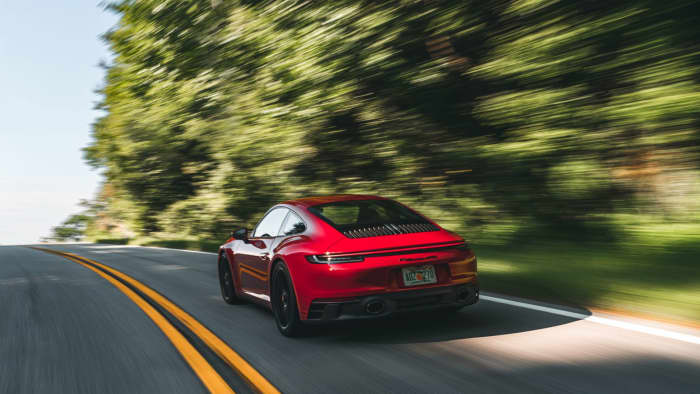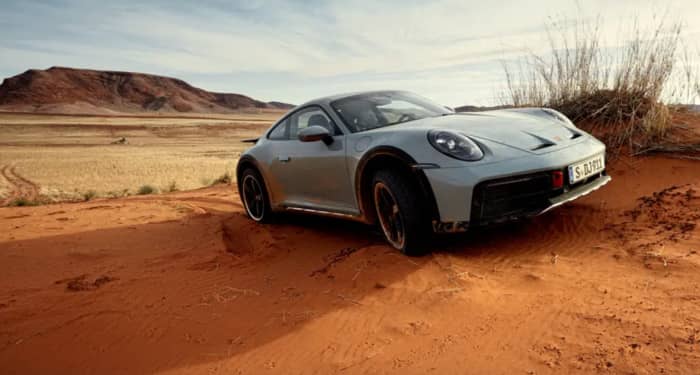
Pros
- A driver’s dream
- Many versions, many choices
- High quality
Cons
- Expensive options
What’s new?
- Range-topping 911 S/T model
The 2024 Porsche 911 remains the high-end sports car against which all others are measured. It’s an awesome machine. Pricing starts at $114,400.
It’s hard to imagine a world without the 911, which is odd because no one today would create a sports car with an engine in the trunk. But that’s part of what makes it so good. When Porsche
POAHY,
We’re now in the eighth generation, which debuted for 2020 and has the factory code of 992 (even though earlier generations have been named 993, 996, and 997). The car is bigger and more luxurious compared with the small and sparse early models. That does underline the 911’s everyday usability, though, and makes it suitable for long trips as well as fast dashes.
Although the 911 might look a bit dull and even commonplace among flashy supercars from the likes of Ferrari, Lamborghini, and McLaren, the driving experience is anything but. And would you really drive a Ferrari
RACE,
Plus: The 10 best new sports cars
What’s new in 2024
The 911 S/T is a special limited edition commemorating the 60th anniversary of the Porsche 911 sports car, with 1,963 units being made. It’s also the lightest variant of this generation. One other thing: Spotify comes on board across the range.
2024 Porsche 911 pricing

The 2024 Porsche 911
PorscheThe 2024 Porsche 911 starts at $114,400. That’s for the “base” Carrera model with rear-wheel drive and an automatic transmission. There are lots and lots of options that can mount to lots and lots of money.
| 911 Carrera | $114,400 |
| 911 Carrera 4 | $121,700 |
| 911 Carrera T | $124,900 |
| 911 Carrera S | $131,300 |
| 911 Carrera 4S | $138,600 |
| 911 Carrera GTS | $150,900 |
| 911 Carrera 4 GTS | $158,200 |
| 911 Carrera Cabriolet | $127,200 |
| 911 Carrera 4 | $134,500 |
| 911 Carrera S Cabriolet | $144,100 |
| 911 Carrera 4S Cabriolet | $151,400 |
| 911 Carrera GTS Cabriolet | $163,700 |
| 911 Carrera 4 GTS Cabriolet | $171,000 |
| 911 Targa 4 | $134,500 |
| 911 Targa 4S | $151,400 |
| 911 Targa 4 GTS | $171,000 |
| 911 Turbo | $197,200 |
| 911 Turbo S | $230,400 |
| 911 Turbo Cabriolet | $210,000 |
| 911 Turbo S Cabriolet | $243,200 |
| 911 GT3 | $182,900 |
| 911 GT3 RS | $241,300 |
| 911 Edition 50 Years Porsche Design | $200,700 |
| 911 Dakar | $222,000 |
| 911 S/T | $290,000 |
These are manufacturer’s suggested retail prices and do not include the $1,650 factory-to-dealer delivery fee (destination charge).
At this rarefied level of automotive excellence, there are some intriguing alternatives. For example, the new-for-2024 Mercedes-AMG GT Coupe starts at around $150K. The Mercedes-AMG SL is a soft-top priced from about $110K. The Jaguar F-Type (in its final year of production) starts at $80K. The also-new-for-2024 Maserati GranTurismo comes in at $174K. We could take the expenditure down a notch or three and point out that the Chevrolet Corvette starts in the region of $70K, and the BMW
BMW,
Before buying a new 911, check the Kelley Blue Book Fair Purchase Price to know what you should be paying.
Exceptional resale values
The Porsche 911 is that rare example of an expensive car holding its value extremely well. Hold on to one long enough and look after it, and chances are it will actually go up in value. For the price of gas, insurance, and maintenance, a 911 could turn out to be quite an asset.
Power, ride, and handling

The Porsche 911 Dakar
PorscheThe Carrera and Carrera T models employ a 379-horsepower turbocharged engine and can sprint from a standstill to 60 mph in four seconds. To compare, the new Mercedes
MBG,
From this impressive point, power levels erupt to a titanic 640 horsepower in the Turbo S while acceleration times shrink to just a fraction over two seconds. And when you drive a 911, you can feel the depth of engineering.
There’s a rhythm to driving the 911 that’s different to driving cars with engines up front. When cornering, it’s slow in, fast out. Once past the apex, ease back on the throttle, let the mass of the engine help plant the rear wheels for traction, then blast away. It’s addictive.
Plus: Feed your need for speed: 10 fastest used cars you can get for under $30,000
The steering doesn’t have any weight over it, so it’s light, fast, and tingling with feedback. Choose the manual transmission or the automatic. It doesn’t matter; we reckon they’re both great in their own ways, and there will be plenty of enthusiasts willing to accept a stick shift should you ever decide to sell your precious Porsche 911.
We’ve found that the brakes are similarly well-engineered and confident. That’s especially true of the ceramic composite brakes that won’t warp or fade after a hard day on the track.
One of the many clichés regarding the 911 is that it’s a supercar you can drive every day. Clichés come about because they’re true. The hardcore GT3 RS will be a tad too focused for some tastes, though. It’s a 518-horsepower rocket derived from an endurance racer, right down to a drag reduction system to change the car’s aerodynamics on straight parts of a track.
The 911 Dakar is set up to look and run like a desert racer, with a raised suspension (a couple of inches higher than a regular 911), all-wheel drive, all-terrain tires, Rallye/Off-Road driving modes, and a fixed rear spoiler.
We’ve spent hundreds of hours driving and evaluating this generation of sports cars, including the Porsche 911.
Fuel economy
It’s only logical that a high-performance car is not going to be a fuel economy champ. The best the 911 can manage is 20 mpg in combined city and highway driving. That’s with the 3.0-liter engine, regardless of which transmission is bolted in. Something like the GT3 achieves 15 mpg combined. Premium gasoline is required throughout.
Also on MarketWatch: Investors are taking more risk as we near the end of 2023
Focused interior
We won’t criticize the 2024 Porsche 911 for having two small seats in the back. It’s been like this since the early 1960s when the original 911 came out, so it’s hardly a terrible surprise. They won’t accommodate anyone over five feet tall, but they fold to create extra luggage space.
Porsche keeps the cabin uncluttered yet sufficient with luxury and design flair to help justify the pricing. The materials and build quality are also suitably beautiful. The company offers a wide range of color schemes, including the seat belts.
Naturally, for a driver’s car, it’s easy to find an ideal position behind the perfectly sized steering wheel. The 911 can be a car for quick, big-thrill blasts yet comfortable enough for lengthy trips as well.
For those longer journeys, there’s also a storage area under the hood since the engine is in the back.
Three body styles
The 2024 911 comes in coupe, convertible (Cabriolet), and Targa body styles. The Cabriolet has a power-folding fabric roof. The Targa has a power-operated roof panel that folds into the back of the car for a predominantly convertible-like driving experience. The non-hardtop versions add some weight, which won’t please the purists, but it’s good to have the choice.
The new S/T offers an exclusive color: Shore Blue Metallic. A lot of this car’s body panels are made from carbon fiber reinforced plastic (CFRP). And buyers can choose which number to have on their doors, well, any figure between 0 and 99.
Our favorite features and tech
911 Carrera
Yes, the “basic” model. There’s a purity to it. No one really needs greater engine power for public roads; rear-wheel drive is the classic layout anyway, and things like 18-way power-adjustable front seats just add weight. It’s just you and the car and the road.
Wireless Apple CarPlay/Android Auto
Cablefree integration saves taking the phone out of a pocket or purse and means it’s not moving around inside the cabin — standard in every new 911.
ParkAssist
Parking sensors at both ends are standard in the base 911 Carrera. It’s a good thing because it’s not always easy to gauge distances when both the hood and tail dip down.
Sport Chrono package
Optional in some 911 variants and standard in a few others, this adds a clock/stopwatch to the center of the dashboard and a launch mode to the automatic transmission.
Burmester audio
If the sound from the 911’s exhaust system is not musical enough for you — it has become a little more subdued since Porsche adopted turbocharging across most of the lineup — then this optional 13-speaker, 855-watt surround-sound system should get those eardrums dancing.
911 S/T
Yes, the most expensive model. Based on the GT3 — but with a kinder, less track-focused setup — it comes with lightweight body parts (including the glass) and magnesium wheels for an advantageous power-to-weight ratio. It’s a limited run, so it’s bound to become a collector’s item.
Also see: The Porsche Cayenne has big upgrades for 2024, with as much driving pleasure as ever
Engine and transmission
Every new 911 has a 6-cylinder engine configured in the traditional Porsche flat-6 arrangement. And keeping with another tradition, they’re all located in the trunk. Most variants also sport a turbocharger (even some not called Turbo), but the GT3 engines are naturally aspirated and especially high-revving.
Rear-wheel drive is the basic setup, with all-wheel drive fitted to the Carrera/Carrera S 4 models, the Targa versions, and the Turbo/Turbo S variants.
A 7-speed manual transmission is mostly standard (the S/T comes with a 6-speed stick shift). The Porsche’s 8-speed automated transmission (known as PDK) is an excellent complement and comes with shift paddles mounted behind the steering wheel for when the driver wants to get more involved — which will probably be quite often.
The 3.0-liter unit in the Carrera, Carrera T, and Targa models makes 379 horsepower and 331 lb-ft of torque. The Carrera S and Targa 4S enjoy 443 horsepower and 390 lb-ft of torque. The Carrera GTS, Targa 4 GTS, 50 Years Edition, and 911 Dakar versions come with 473 horsepower and 420 lb-ft of torque.
The 3.7-liter Turbo develops 572 horsepower and 553 lb-ft of torque, while the Turbo S generates 640 horsepower and 590 lb-ft of torque. The 4.0-liter GT3 spins up to 502 horsepower and 346 lb-ft of torque; the GT3 RS is endowed with 518 horsepower and 342 lb-ft of torque — this engine is also in the new 911 S/T.
Also see: I got to drive the new McLaren Artura supercar—here’s what I learned about myself, cars and…cows
4-year/50,000-mile warranty
Typical for a European luxury marque, Porsche’s new-vehicle and powertrain warranties last four years or 50,000 miles, whichever comes first. This includes 24-hour roadside assistance.
Safety ratings
The 911 hasn’t been crash-tested by any agencies in the U.S. Forward collision warning is part of the same optional package that includes adaptive cruise control.
KBB’s car review methodology.
This story originally ran on KBB.com.














